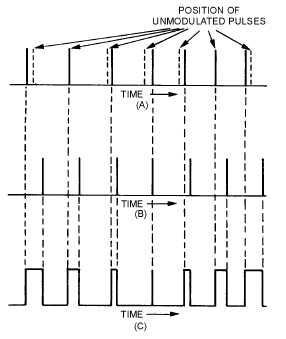3-25
pass filter, the average voltage across the filter will vary in the same way as the original modulating
voltage. This varying voltage will closely approximate the original modulating voltage.
CONVERSION
Pulse-position modulation (ppm), pulse-frequency modulation (pfm), and pulse-code modulation
(pcm) are most easily demodulated by first converting them to either pdm or pam. After conversion these
pulses are demodulated using either peak detection or a low-pass filter. This conversion may be done in
many ways, but your study will be limited to the simpler methods.
Pulse-Position Modulation
Ppm can be converted to pdm by using a flip-flop circuit. (Flip flops were discussed in NEETS,
Module 9, Introduction to Wave-Generation and Wave-Shaping Circuits.) Figure 3-22 shows the
waveforms for conversion of ppm to pdm. View (A) is the pulse-modulated pulse train and view (B) is a
series of reset trigger pulses. The trigger pulses must be synchronized with the unmodulated position of
the ppm pulses, but with a fixed time delay from these pulses. As the position-modulated pulse is applied
to the flip-flop, the output is driven positive, as shown in view (C). After a period of time, the trigger
pulse is again generated and drives the flip-flop output negative and the pulse ends. Because the ppm
pulses are constantly varying in position with reference to the unmodulated pulses, the output of the flip-
flop also varies in duration or width. This pdm signal can now be applied to one of the circuits that has
already been discussed for demodulation.
Figure 3-22.—Conversion of ppm to pdm.
Pulse-frequency modulation is a variation of ppm and may be converted by the same method.

